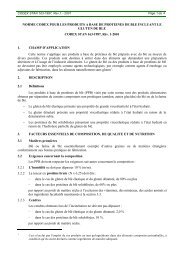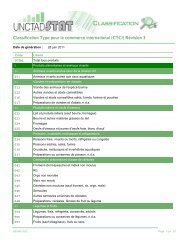issues and constraints related to the development of cashew nuts ...
issues and constraints related to the development of cashew nuts ...
issues and constraints related to the development of cashew nuts ...
You also want an ePaper? Increase the reach of your titles
YUMPU automatically turns print PDFs into web optimized ePapers that Google loves.
15 GhanaThe germplasm collection <strong>of</strong> UDS/SARI (University <strong>of</strong> Development Studies/SavannahAgriculture Research Institute) at Tamale consisted <strong>of</strong> trees grown from seed, taken from sixtylocal “selected mo<strong>the</strong>r trees”. Eight seeds from each <strong>of</strong> <strong>the</strong> 60 mo<strong>the</strong>r trees were planted in 1997,in one replicate.The material used for planting <strong>the</strong> Pokuase germplasm collection, near Accra, was seed fromlocal trees. The performance <strong>of</strong> <strong>the</strong> mo<strong>the</strong>r trees was not evaluated; seeds were simply collectedfrom trees around <strong>the</strong> vicinity. About 50% <strong>of</strong> <strong>the</strong> seedlings were dead. Such a trial has very littlevalue.Technoserve Ghana has imported seed from <strong>the</strong> CP range <strong>of</strong> Brazilian clones <strong>and</strong> “jumbo” <strong>nuts</strong>from Nigeria. Over 20 <strong>to</strong>ns <strong>of</strong> “jumbo” <strong>nuts</strong> have been imported since 1995 <strong>and</strong> more were beingimported in 2001; this material is being sold <strong>to</strong> farmers. There appears <strong>to</strong> be no evaluation <strong>of</strong><strong>the</strong>se introductions by research or NGOs.At <strong>the</strong> MIM estate in Ghana, some <strong>of</strong> <strong>the</strong> trees were grown from seed from India, <strong>and</strong> <strong>the</strong> rest <strong>of</strong><strong>the</strong> seed were obtained from an old local plantation, at Sampa. Now <strong>the</strong>y are selecting mo<strong>the</strong>rtrees from <strong>the</strong>ir own plantation based on yield <strong>and</strong> nut size. It was useful <strong>to</strong> note that treesoriginating from seed from India were more susceptible <strong>to</strong> damage by thrips.Technoserve Ghana initiated <strong>the</strong> selection <strong>of</strong> mo<strong>the</strong>r trees in 1994, but found that trees producedfrom <strong>the</strong> seed were very variable. Seed provided <strong>to</strong> farmers working with ADRA was obtainedfrom selected mo<strong>the</strong>r trees in Wenchi district, <strong>and</strong> subsequently from MOFA (Ministry <strong>of</strong> Food<strong>and</strong> Agriculture), again from selected local mo<strong>the</strong>r trees. All <strong>of</strong> this new planting will be veryvariable <strong>and</strong> much <strong>of</strong> it without any particularly desirable qualities.As already mentioned before, <strong>the</strong>re are some evaluation <strong>of</strong> local “mo<strong>the</strong>r tree” selections, butlittle else. No vegetative propagation <strong>of</strong> <strong>cashew</strong> is being undertaken. It is only recently that <strong>the</strong>issue <strong>of</strong> <strong>cashew</strong> research has been given any priority by <strong>the</strong> Government. NigeriaThe CRIN (Cocoa Research Institute <strong>of</strong> Nigeria) sub-station at Ochaja was ‘home’ <strong>to</strong> a number <strong>of</strong>breeding trials, namely:o ‘Block NW-7’ was <strong>the</strong> original germplasm collection planted in 1977, with half-sibaccessions from Brazil, India, Tanzania, o<strong>the</strong>r countries <strong>and</strong> locally selected material.There were 32 plots <strong>of</strong> four trees (i.e. four seeds from one tree) replicated twice. Eighteentypes have been selected for farmer planting.o Brazilian “jumbo nut” trial – <strong>the</strong>se <strong>nuts</strong> were obtained from Kosoni Farm (Oro, KwaraState). They were graded according <strong>to</strong> weight <strong>and</strong> <strong>the</strong>n <strong>the</strong> entire block <strong>of</strong> seven ha wasplanted according <strong>to</strong> nut weight, that is, <strong>the</strong> smallest <strong>nuts</strong> at one end, rising <strong>to</strong> <strong>the</strong> biggest<strong>nuts</strong> at <strong>the</strong> o<strong>the</strong>r. Spacing was 9 x 9 m. The <strong>nuts</strong> were not from selected trees.o Millennium block – Brazilian jumbo type <strong>nuts</strong> were being evaluated at different spacing,9 x 9m, 8 x 8m <strong>and</strong> 6 x 6m. Again each plot was planted according <strong>to</strong> nut weight, with<strong>the</strong> lower weight <strong>nuts</strong> at one end moving <strong>to</strong> <strong>the</strong> highest weights at <strong>the</strong> o<strong>the</strong>r end.o O<strong>the</strong>r trials were also made, <strong>and</strong> some <strong>of</strong> <strong>the</strong> older ones had been earmarked forupgrading trials.


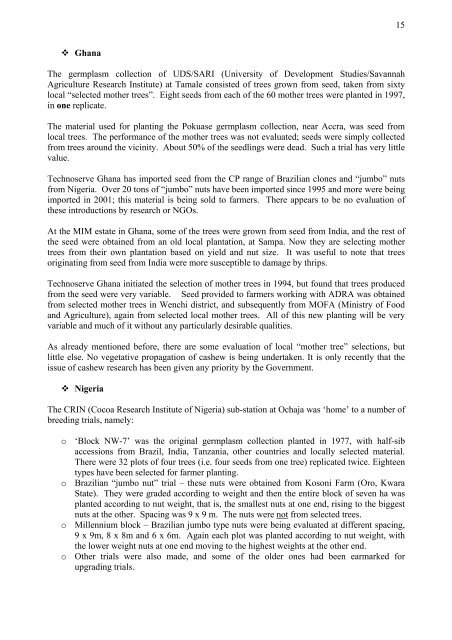
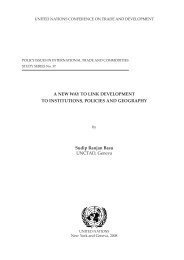


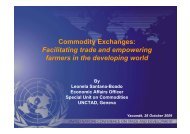
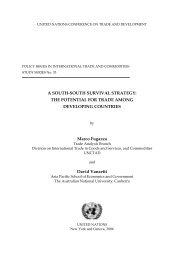
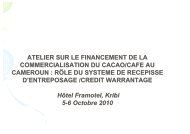
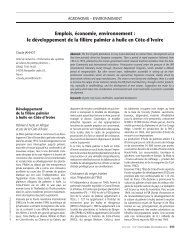
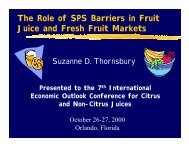

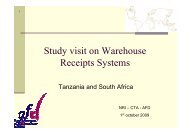
![Warehouse Receipt Systems: Legal Issues [PDF]](https://img.yumpu.com/43979338/1/190x134/warehouse-receipt-systems-legal-issues-pdf.jpg?quality=85)
